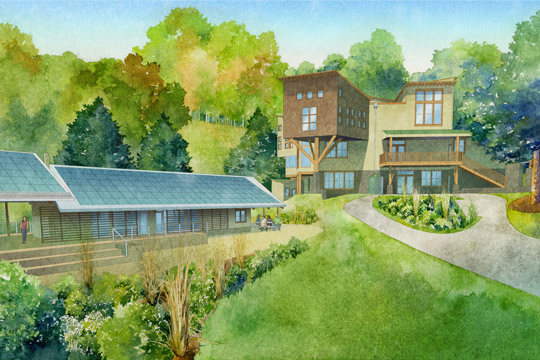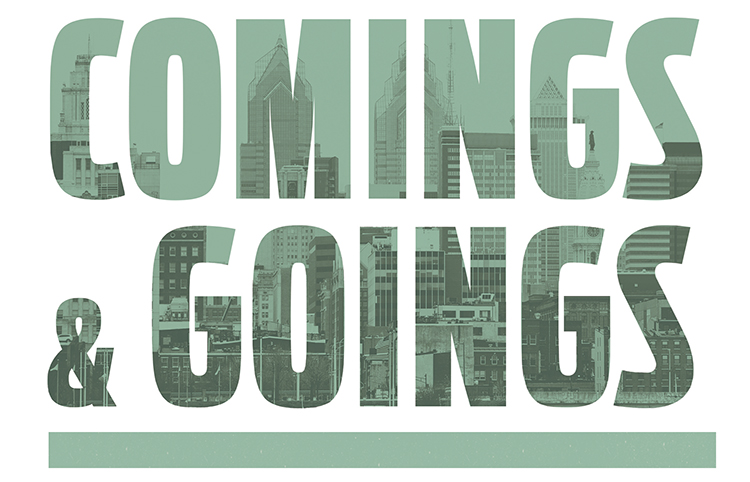The Living Building Challenge demands that teams exceed LEED requirements to create buildings that restore nature
An artist rendering of Re:Vision Architecture’s concept for the Alice Ferguson Foundation’s multi-building complex. | Courtesy Alice Ferguson Foundation
by Sara Schwartz
The Living Building Challenge is the black belt of the green-building scene. The international building certification program, philosophy and advocacy tool was conceived in 2006 as a way to exceed LEED requirements—the standard in green building certification—challenging designers, builders and architects to build advanced sustainable buildings.
To be certified as a Living Building, seven categories must be met. The categories are represented as petals on a flower, and they are: Place, Water, Energy, Health & Happiness, Materials, Equity, and Beauty. Each petal is subdivided into 20 Imperatives. Nearly any building project—new or existing—of any scale in any location is eligible.
It’s so strict that there are only five buildings fully certified in the world—all in the U.S. The impetus to create the Living Building Challenge occurred when Cascadia Green Building Council—the U.S. Green Building Council chapter in the Northeast U.S. and part of Canada—wanted to improve upon LEED standards, which started in 1998. The group has since spun off into a separate 501c3 organization, The International Living Future Institute, with offices in Seattle, Portland and Vancouver.
Although there are no Living Building Challenge certified projects in our city, Philadelphia firm Re:Vision Architecture is working—as either consultants or architects—on six that are in progress elsewhere. One soon to be completed, and about to begin its year-long performance period, is 150 miles away in Southern Maryland, at the Alice Ferguson Foundation’s Hard Bargain Farm, an environmental educational nonprofit and a 330-acre farm that works primarily with students. In 2006, the Foundation needed to replace its overnight lodge and construct a new education building. Initially aiming for LEED, the Foundation opted to go further, says Lori Arguelles, Executive Director of the Alice Ferguson Foundation.
“We wanted to ‘walk the talk,’ ” Arguelles writes in an email. “Our goal is to help inform the next generation of environmental stewards and what better way to do than by embracing the Living Building Challenge.”
The zero-energy, zero-water, zero-toxicity and carbon neutral educational facilities were designed to restore a healthy local ecosystem.The education building, which will generate energy using solar panels, and the overnight lodge, which will gather water for the complex, is expected to be completed in 2016.
Scott Kelly, principal of Re:Vision, worked on the complex and appreciates that synergy: “Each building works very much like nature, they work collaboratively with each other.”
Kelly is trained as an architect with a background in historic preservation and adaptive reuse. About a decade ago, he dedicated himself to only work on green building projects: “If it’s not a green project, don’t hire us because we don’t want to do it.” He’s one of the founders of the Delaware Valley Green Building Council (DVGBC) and he’s worked on many zero-energy buildings, zero-water buildings and zero-toxicity buildings, a “couple hundred” LEED projects and 30-plus LEED Platinum-level projects.
“The goal of the Living Building Challenge is to challenge what we think is possible and to create the imagination to visualize a future that is ecologically restorative, socially just and culturally rich,” says Amanda Sturgeon, executive director of the International Living Future Institute.
Kelly says that the best way for new buildings to become Living Building Challenge certified is to begin at the design process. Teams are expected to register the project, finish the design, submit design documents for approval, build the building, submit construction documents, then, a year later, submit actual data to prove performance.
There are currently 25 buildings worldwide that are in the performance period, and approximately 225 buildings worldwide pursuing full Challenge certification, Sturgeon says. Kelly adds that fewer than half of the projects that pursue certification actually succeed. But that’s what he loves about the Challenge. It’s not predictive performance, it’s proven performance. “You can use computer modeling and prove anything is zero-energy,” he says. “You have to show [the Living Building Future Institute] your energy bill after a year and if it says ‘zero,’ you’re in, and if it says ‘$1,’ you’re out. There’s a beauty in that.”
While there are no buildings in the Philadelphia region that have met the Challenge, Kelly says there’s a confidential project that has registered with the Living Building Future Institute and is pursuing certification. In addition, he and others dedicated to promoting the Challenge created the Living Building Challenge Philadelphia Collaborative, a group that advocates the Challenge. “Every meeting, we make sure we have fun,” Kelly says. And all are welcome.
“It’s a very diverse group,” Kelly adds. “What’s common is that most have an environmental ethic, they all care.”
The DVGBC has been supportive of the Living Building Futures Institute and the new Philadelphia group. Outgoing DVGBC Executive Director Janet Milkman promotes the meetings and helps connect those who want to engage with the group. She is optimistic about more architects and builders aiming for Living Building Challenge certification.
“It will grow just as the green building community grew in Philadelphia—with a core group of highly engaged practitioners learning together about how to make the [Living Building Challenge] standard work in our region,” she says.
That core group is already having fun spreading the word about the Living Building Challenge and encouraging others to get involved.
“What I love about the Living Building Challenge [is] the goal isn’t to minimize our impact—it’s to restore the environment back to a way that can sustain life,” Kelly says. “Because what we all know is we can’t sustain life the way we’re living. … The intent of Living Building Challenge is to get us back in check and balance with our natural environment.”





This is a great step forward for Philadelphia and its residents!
Sara: Thank you for this article and what is perhaps the best opening line ever in a story about the Living Building Challenge!
Scott Kelly and Re:Vision Architecture have long been pioneers in green building in Philadelphia (and the entire Delaware Valley). We're thrilled to see this project come to life under their hands and excited for them to have a building like this to serve as a model and inspiration for others to duplicate.
Given the intense environmental impact of buildings, we need more buildings like the Alice Ferguson Foundation’s Hard Bargain Farm, projects that produce more energy than they consume, collect more water than they use and avoid known harmful chemicals. There are now over 235 LBC projects around the world (totaling 9M square feet) and each one serves as a role model. Any where you find a Living Building, you'll usually find some groundbreaking new precedent (such as the first building in the area to use waterless toilets, or the first to collect rainwater).
Most inspiring article / manifesto. It is a challenge for the world and the only solution / way out to the future in the architecture and design practice. Thanks for sharing and wish to read more of this fantastic journey.
Best Regards,
CMF